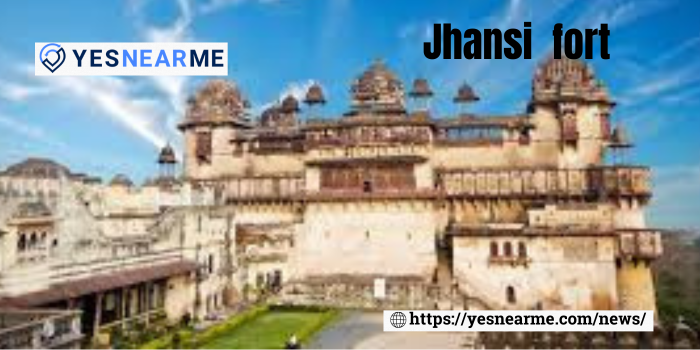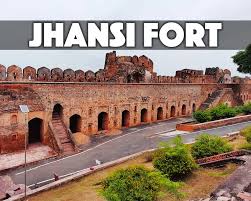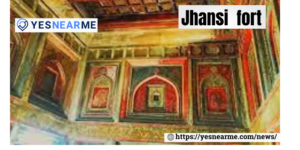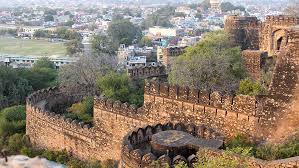
‘ ); } ?>
Table of Contents
Introduction
Raja Bir Singh constructed the great Jhansi fort in the great Bundela Dynasty, and it is well known for the bravery of Queen Rani Laxmibai. The fort, which is located in the largest state of India,

The largest fort of Jhansi Fort has a large area across 15 acres. Thick walls surround the fort, which were very helpful in protecting it from any attack. Builders used granite stone to construct the fort.It has many entrances such as Khanderao Gate, Laxmi Gate, Orchha Gate and Sagar Gate, it also has Kadak Bijli cannon to provide water supply. It has two important temples Ganesh and shiva.
The most important part of the fort is the Rani Mahal residence of Rani Laxmibai. Let’s explore more about Rani Mahal.
Rani Mahal- The residence of Rani Laxmibai in Jhansi Fort
The Rani Mahal, where Rani Laxmibai used to live, is the most important part of the Jhansi Fort. Raghunath Nawalkar II founded this monument, and Rani Laxmibai later used it as her residence. It is a double storied building covered from three sides except the west, and the original wooden roof and lintels are still visible and in good condition. The walls of the Mahal were painted with peacock, duck, lotus, etc., and different paintings with red color adorn the inner part of the Mahal.

Rani Mahal- Source-Tripoto
More places to explore-
At the last if you are willing to explore more about Jhansi Fort there are few more places which you can also visit nearby fort.
- Government museum Jhansi
- Laxmi Tal
- Mahalakshmi Temple
- the cenotaph of Raja Gangadhar Rao (husband of Rani Lakshmi Bai)
- Rani Lakshmibai Park
- Rai Praveen Mahal
Jhansi Fort entry fee and timings-
Indians: 20 Rs Entry Fee
SAARC, BIMSTEC Country Visitors: 15 Rs Ticket Price
Foreigners: Rs 250 Admission Charges
Children Below 15 Years: Entry Free
Address–
Near Lakshmi Bhai Park, Jhokan Bagh, Jhansi, Uttar Pradesh
This is the best monument of India which has a very important role in Indian History. The Jhansi Fort is located at the top of Bagira, a hill situated in Uttar Pradesh in the northern part of India. It is a 17th-century architectural monument that has undergone royal construction followed by massive destruction in the first War of Independence against the British East India Companyhttps://en.wikipedia.org/wiki/Jhansi_Fort
Conclusion :
Jhansi Fort stands as a proud symbol of India’s rich history and bravery. It played a crucial role in the fight for independence, especially under the leadership of Rani Lakshmibai. The fort’s grand structure, historical significance, and strategic location make it a must-visit site for history enthusiasts. Today, it serves as a reminder of the courage and sacrifice of those who fought for their homeland. Visiting Jhansi Fort offers a glimpse into India’s glorious past and inspires a deep sense of pride and patriotism.
झाशी किल्ल्याचा इतिहास आणि महत्त्व
झाशी किल्ला उत्तर प्रदेशमधील झाशी शहरात वसलेला आहे. हा किल्ला प्राचीन ऐतिहासिक महत्त्वाचा असून तो भारतीय स्वातंत्र्यलढ्यातील एक महत्त्वाचा साक्षीदार आहे. झाशीच्या राणी लक्ष्मीबाईच्या शौर्याची आठवण करून देणारा हा किल्ला अनेक ऐतिहासिक घटनांचा साक्षीदार आहे.

झाशी किल्ल्याचा इतिहास
झाशी किल्ला १७वीं शतकात ओरछा राज्याचे राजा बीरसिंह देव बुंदेला यांनी बांधला. हा किल्ला बुंदेलखंड प्रदेशाच्या संरक्षणासाठी उभारण्यात आला होता. त्यानंतर झाशी अनेक राज्यकर्त्यांच्या अधिपत्याखाली गेला. मराठ्यांनी १८ व्या शतकात हा किल्ला ताब्यात घेतला आणि तो झाशीच्या प्रमुख ठिकाणांपैकी एक बनला.
१८५७ च्या स्वातंत्र्य संग्रामात झाशी किल्ल्याची महत्त्वपूर्ण भूमिका होती. इंग्रजांनी झाशीच्या राणी लक्ष्मीबाई यांच्यावर आक्रमण केले तेव्हा त्यांनी अपार शौर्याने इंग्रजांविरुद्ध संघर्ष केला. “मी माझी झाशी देणार नाही” असे प्रतिज्ञा घेत राणी लक्ष्मीबाई यांनी या किल्ल्यावरून युद्ध लढले आणि आपल्या मातृभूमीसाठी बलिदान दिले.
किल्ल्याची वास्तुकला
झाशी किल्ला भव्य आणि मजबूत बांधणीसाठी ओळखला जातो. हा किल्ला बांधण्यासाठी मोठ्या दगडांचा वापर करण्यात आला आहे. किल्ल्यातील प्रमुख प्रवेशद्वार “कदम सिंह दरवाजा” असून, आत अनेक महत्त्वाचे भाग आहेत, जसे की गणेश मंदिर, शिव मंदिर, बारादरी आणि तोफा ठेवण्याची जागा. किल्ल्याच्या भिंती मजबूत असून त्या संरक्षणासाठी उभारल्या गेल्या आहेत. किल्ल्याच्या परिसरातून संपूर्ण झाशी शहराचे सुंदर दृश्य दिसते.
झाशी किल्ल्याचे ऐतिहासिक महत्त्व
१. स्वातंत्र्यलढ्यातील योगदान – १८५७ च्या उठावात झाशी किल्ला क्रांतीचे केंद्र बनला. राणी लक्ष्मीबाई आणि त्यांच्या सैनिकांनी इंग्रजांविरुद्ध युद्ध केले. 2. संरक्षणाची भक्कम व्यवस्था – किल्ला उंचीवर असल्याने तो सैन्य दृष्टिकोनातून अत्यंत महत्त्वाचा होता. 3. पर्यटन केंद्र – आज झाशी किल्ला देश-विदेशातील पर्यटकांसाठी एक प्रमुख आकर्षण आहे.
पर्यटन आणि वारसा
आज झाशी किल्ला भारतीय पुरातत्व सर्वेक्षण विभागाच्या देखरेखीखाली आहे. येथे दरवर्षी मोठ्या प्रमाणात पर्यटक भेट देतात. विशेषतः १८५७ च्या स्वातंत्र्य संग्रामाच्या स्मरणार्थ येथे दरवर्षी “झाशी महोत्सव” साजरा केला जातो, ज्यामध्ये विविध सांस्कृतिक कार्यक्रम होतात.
